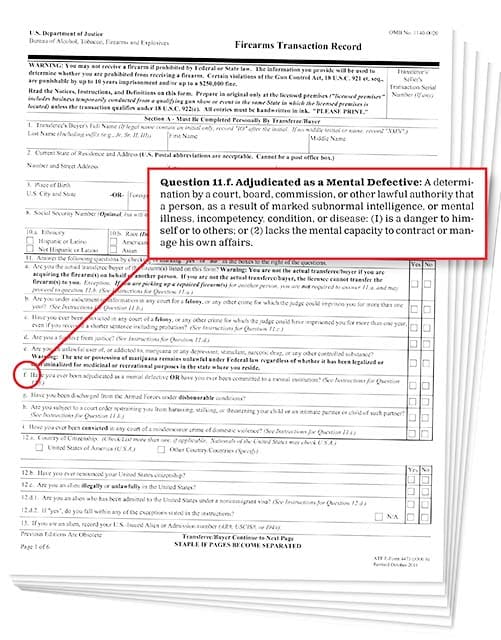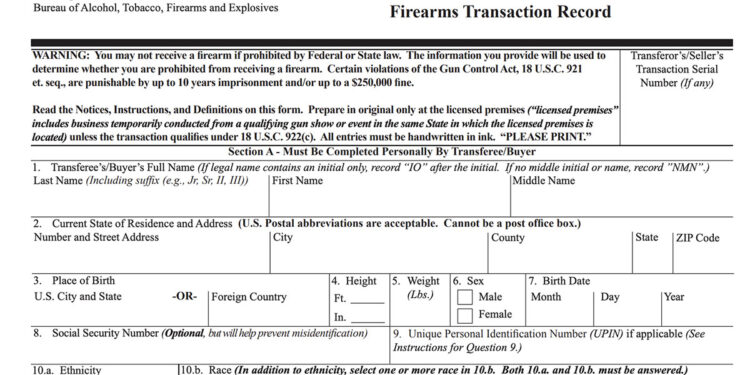By Linda M. Gilbertson
The 1960s was a tumultuous decade. The Vietnam War protests, the Woodstock Festival, the decade of “Drugs, Sex and Rock & Roll,” three assassinations, the civil rights movement and urban race rioting all led to the Gun Control Act of 1968 and the formation of the ATF Form 4473—Firearms Transaction Record used in all firearms purchases today.
The three assassinations were President John F. Kennedy, civil rights leader Dr. Martin Luther King, Jr. and U.S. Senator Robert F. Kennedy. At the time of the third assassination, Lyndon B. Johnson was president and pleaded with Congress “in the name of sanity … in the name of safety and in the name of an aroused nation, give America the gun control laws it needs.” The polls showed that approximately 80% of Americans favored gun registration laws. President Johnson proposed and Congress passed on October 22, 1968, the Gun Control Act of 1968, 18 U.S.C. 921, et seq. National gun registration although proposed, was not included in the Act and was dropped to as-sure the Act’s passage in Congress.
Because the firearms used by the three assassins had variously been purchased through mail order, over-the-counter by a convicted felon and acquired by an illegal alien, the legislation had three major features:
- It prohibited interstate traffic in firearms and ammunition.
- It denied guns to specific classes of individuals such as felons, minors, fugitives, illegal aliens, drug addicts and the mentally ill (ATF Form 4473).
- It prohibited the importation of surplus military weapons into the U.S. as well of guns and ammunition not federally certified as sporting weapons or souvenirs.
The ATF Form 4473 has been utilized for 50 years. Very few changes have been made to the form until October 2016 when states voted to decriminalize marijuana. Once abhorrent behavior, marijuana use became acceptable.
Medical and Recreation Marijuana
I grew up during the 1960s, the decade of rebellion, with the incumbent breakdown of morals, values and ethics in our society. Many of the young people who participated in the rebellion of the 60s are in positions in society today to change the country. Many of them went into the fields of education, journalism and politics. The use of marijuana back then was considered the steppingstone to other drugs. It led to LSD, cocaine, heroin, PCP, etc. Possession and use were criminalized. Marijuana users in the 60s are in positions of persuasion today and have successfully convinced society at the state level that legalizing “pot” for medical and recreational use is moral and necessary.
However, there’s an underlying problem. It is still against federal law to use or possess marijuana. Question 11.e. on the ATF Form 4473 (re-vised 10/2016) asks: “Are you an unlawful user of, or addicted to, marijuana or any depressant, stimulant, narcotic drug or any other controlled substance? Warning: The use or possession of marijuana remains unlawful under Federal law regardless of whether it has been legalized or decriminalized for medical or recreational purposes in the state where you reside.” Anyone who answers YES to this question can’t purchase a firearm. They’ve lost their Second Amendment right.

Adjudication and the Mentally Ill
During the 1960s, psychiatric hospitals became a haven for those who were schizo-phrenic, anti-social, psychotic, drug-addicted, alcoholic, deviant, mentally delayed and for anyone else who normal society couldn’t handle. Over-packed and underfunded, eventually state governments found that medicating and mainstreaming these people were the answer.
According to an article in The New York Times dated 1984, there was a Joint Commission on Mental Illness and Health, set up by Congress in 1955. The finding showed “… the political community wanted to save money … . [T]ran-quilizers became the panacea for the mentally ill … . The state programs were buying them by the carload, sending the drugged patients back to the community, and the psychiatrists never tried to stop this.”
Dr. Jack R. Ewalt, director of the Joint Commission on Mental Illness and Health in 1955, believed that “drugs can help people get back to the community, but they have to have medical care, a place to live and someone to relate to. They can’t just float around aimlessly.”
Dr. Bertram S. Brown, a psychiatrist (and later deputy director of the National Institute of Mental Health), was instrumental in shaping the community center legislation of 1963 (Community Mental Health Act). The discharge of mentally ill patients was accelerated in the late 1960s and early 1970s in some states as a result of court decisions that limited commitment powers of state and local officials. The community center was created to counsel and medicate.
Today, there are few psychiatric hospitals and just as few community centers. Most mentally ill persons, no matter their diagnosis, are mainstreamed and medicated. They’re taken to facilities for initial observation, and psychiatrists determine what medication and what counseling are necessary. Many of these people do not have the ability to care for themselves, let alone make their counseling appointments and take their daily dosage of medication. And, here’s the problem. Very few mentally ill people go through the court system any longer. Most are not adjudicated, so they can legally purchase a firearm. If they had been adjudicated, this information would be sent to the National Information Center and be accessible to licensed firearms dealers.
Question 11.f. on the ATF Form 4473 (re-vised 10/2016) asks: “Have you ever been adjudicated as a mental defective OR have you ever been committed to a mental institution?” The definition for adjudicated as a mental defective is “a determination by a court, board, commission or other lawful authority that a person, as a result of marked subnormal intelligence, or mental illness, incompetency, condition or disease: (1) is a danger to himself or to others; or (2) lacks the mental capacity to contract or manage his own affairs …” (27 CFR §478.11). The definition for committed to a mental institution is “a formal commitment of a person to a mental institution by a court, board, commission or other lawful authority” (27 CFR §478.11).
The ATF Form 4473 has always considered marijuana use and mental illness as abhorrent behavior. What has changed is society’s handling of both. Here are two different behaviors with two different results. One behavior can’t have the Second Amendment right, and the other shouldn’t have the right. A conundrum it appears that nobody wants to tackle.
| This article first appeared in Small Arms Review V24N1 (Jan 2020) |












